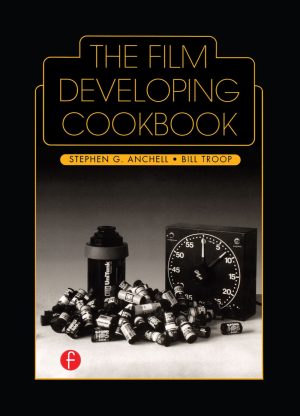The Film Developing Cookbook
by Stephen G. Anchell and Bill Troop

This book will help you to acquire a relevant knowledge of black and white photographic chemistry and processing as easy as possible. An up-to-date manual for photographic film development techniques. This book concentrates on films, their characteristics, and the developers each requires for maximum control of the resulting image.
The Film Developing Cookbook has three special emphases:
- how to use different developers to achieve a wide range of pictorial effects
- how to mix and use solutions from scratch (and how to create new ones)
- how to process film for maximum archival permanence.
The Film Developing Cookbook specifically addresses the difficult subject of T-grain film development. It includes rarely found information on film development and the nature of film developers.
It’s all because of the little yellow box. This book owes its existence to T-Max film. As author of The Darkroom Cookbook I have heard from many associates and students about the difficulty they have obtaining quality images with T-Max film. Many solutions have been put forth; all are compromises.
Finally, I called my friend and photo-chemist, Bill Troop, and asked if he had any suggestions. Bill has designed many fine formulas for developing both films and papers; many are referenced in this book. Bill’s reply was, “No, but I have some ideas.”Not only ideas. Bill had a manuscript he had begun on film processing as early as 1980 which was floating around his home somewhere. He dug it out, sent it to me, and we began the collaboration which led to this book.
—Steve Anchell
When this book was conceived in 1980, photographic engineering was still an important field. But by 1982 photographic manufacturers were moving from traditional silver halide science to digital as fast as they could. They laid off thousands of photographic scientists and replaced them with electrical engineers and computer scientists. I had counted on seeing a lot of fundamental research completed before I finished my book: research into new developers, new films, and new fixing tech niques. This was never to be. It was a depressing time for photography!
I put the book aside until I met Steve Anchell, four years ago. He proved to me that there are still countless dedicated photographers who are interested in exerting the greatest possible control over film processing. So Steve and I set about completely rewriting and re- researching my material. We have tried to include all the essential information yet make it interesting enough for photographers to enjoy reading.
—Bill Troop
Contents
Introduction
Index of Formulas
Chapter 1 – Developer Categories
Chapter 2 – Films
Chapter 3 – Developer Ingredients
Chapter 4 – Development Procedures
Chapter 5 – Solvent Developers (Fine Grain)
Chapter 6 – Non-solvent Developers (High Definition)
Chapter 7 – Super-fine Grain Developers
Chapter 8 – Tanning Developers
Chapter 9 – Special Developers
Chapter 10 – Increasing Film Speed
Chapter 11 – Document Films
Chapter 12 – After Development Processes: Stop Baths, Fixers, Washing
Appendices
I: Reference Formulas
II: Mixing Solutions 129 III: Chemical Safety 137 Bibliography
Sources
Developing Time Chart
Temperature Conversion Chart
Index
